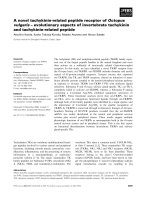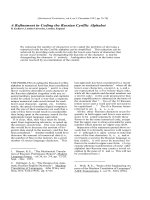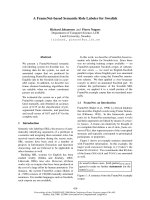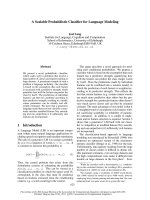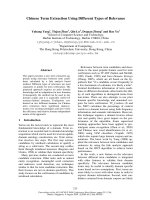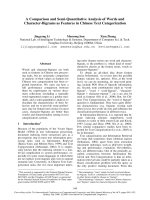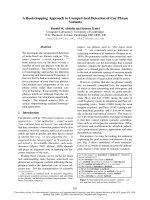Báo cáo khoa học: "A Multi-Neuro Tagger Using Variable Lengths of Contexts" pdf
Bạn đang xem bản rút gọn của tài liệu. Xem và tải ngay bản đầy đủ của tài liệu tại đây (392.52 KB, 5 trang )
A Multi-Neuro Tagger Using Variable Lengths of Contexts
Qing Ma and Hitoshi
Isahara
Communications Research Laboratory
Ministry of Posts and Telecommunications
588-2, Iwaoka, Nishi-ku, Kobe, 651-2401, Japan
{qma, isahara}@crl.go.jp
Abstract
This paper presents a multi-neuro tagger that
uses variable lengths of contexts and weighted
inputs (with information gains) for part of
speech tagging. Computer experiments show
that it has a correct rate of over 94% for tag-
ging ambiguous words when a small Thai corpus
with 22,311 ambiguous words is used for train-
ing. This result is better than any of the results
obtained using the single-neuro taggers with
fixed but different lengths of contexts, which
indicates that the multi-neuro tagger can dy-
namically find a suitable length of contexts in
tagging.
1 Introduction
Words are often ambiguous in terms of their
part of speech (POS). POS tagging disam-
biguates them, i.e., it assigns to each word the
correct POS in the context of the sentence.
Several kinds of POS taggers using rule-based
(e.g., Brill et al., 1990), statistical (e.g., Meri-
aldo, 1994), memory-based (e.g., Daelemans,
1996), and neural network (e.g., Schmid, 1994)
models have been proposed for some languages.
The correct rate of tagging of these models
has reached 95%, in part by using a very large
amount of training data (e.g., 1,000,000 words
in Schmid, 1994). For many other languages
(e.g., Thai, which we deal with in this paper),
however, the corpora have not been prepared
and there is not a large amount of training data
available. It is therefore important to construct
a practical tagger using as few training data as
possible.
In most of the statistical and neural network
models proposed so far, the length of the con-
texts used for tagging is fixed and has to be
selected empirically. In addition, all words in
the input are regarded to have the same rele-
vance in tagging. An ideal model would be one
in which the length of the contexts can be au-
tomatically selected as needed in tagging and
the words used in tagging can be given different
relevances. A simple but effective solution is to
introduce a multi-module tagger composed of
multiple modules (basic taggers) with fixed but
different lengths of contexts in the input and
a selector (a selecting rule) to obtain the final
answer. The tagger should also have a set of
weights reflecting the different relevances of the
input elements. If we construct such a multi-
module tagger with statistical methods (e.g., n-
gram models), however, the size of the n-gram
table would be extremely large, as mentioned in
Sec. 4.4. On the other hand, in memory-based
models such as IGtree (Daelemans, 1996), the
number of features used in tagging is actually
variable, within the maximum length (i.e., the
number of features spanning the tree), and the
different relevances of the different features are
taken into account in tagging. Tagging by this
approach, however, may be computationally ex-
pensive if the maximum length is large. Actu-
ally, the maximum length was set at 4 in Daele-
mans's model, which can therefore be regarded
as one using fixed length of contexts.
This paper presents a multi-neuro tagger
that is constructed using multiple neural net-
works, all of which can be regarded as single-
neuro taggers with fixed but different lengths of
contexts in inputs. The tagger performs POS
tagging in different lengths of contexts based on
longest context priority. Given that the target
word is more relevant than any of the words
in its context and that the words in context
may have different relevances in tagging, each
802
element of the input is weighted with informa-
tion gains, i.e., numbers expressing the average
amount of reduction of training set informa-
tion entropy when the POSs of the element are
known (Quinlan 1993). By using the trained re-
sults (weights) of the single-neuro taggers with
short inputs as initial weights of those with long
inputs, the training time for the latter ones can
be greatly reduced and the cost to train a multi-
neuro tagger is almost the same as that to train
a single-neuro tagger.
2 POS Tagging Problems
Since each input Thai text can be segmented
into individual words that can be further tagged
with all possible POSs using an electronic Thai
dictionary, the POS tagging tasks can be re-
garded as a kind of POS disambiguation prob-
lem using contexts as follows:
IPT : (iptdt, , ipt-ll, ipt_t, ipt_rl, , ipt_rr)
OPT : POS_t,
(1)
where
ipt_t
is the element related to the possible
POSs of the target word,
(ipt_lt, , ipt_ll)
and
(ipt_rl, ,ipt_rr)
are the elements related to
the contexts, i.e., the POSs of the words to the
left and right of the target word, respectively,
and
POS_t
is the correct POS of the target word
in the contexts.
3 Information Gain
Suppose each element,
ipt_x (x = li,t,
or rj),
in (1) has a weight, w_z, which can be obtained
using information theory as follows. Let S be
the training set and
Ci
be the
ith class,
i.e.,
the
ith
POS (i = 1, ,n, where n is the total
number of POSs). The entropy of the set S,
i.e., the average amount of information needed
to identify the class (the POS) of an example in
5',
is
in f o( S) = _ ~-~ f req( Ci, S) ~(~]i, S) ),
ISl
x In( fre
(2)
where
ISl
is the number of examples in S and
freq(Ci, S)
is the number of examples belong-
ing to class Ci. When S has been partitioned
to h subset
Si (i = 1, ,h)
according to the
element
ipt.x,
the new entropy can be found as
the weighted sum over these subsets, or
infox(S) = ~ × info(Si).
(3)
i=1
Thus, the quantity of information gained by this
partitioning, or by knowing the POSs of element
ipt_x,
can be obtained by
gain(x) = info(S) - in fox(S),
(4)
which is used as the weight, w_T, i.e.,
w_x= gain(x).
(5)
4
Multi-Neuro Tagger
4.1 Single-Neuro Tagger
Figure 1 shows a single-neuro tagger (SNT)
which consists of a 3-layer feedforward neural
network. The SNT can disambiguate the POS
of each word using a fixed length of the con-
text by training it in a supervised manner with
a well-known error back-propagation algorithm
(for details see e.g., Haykin, 1994).
OPT
ipt l I ipt_l I ipt__t ipt_r I -" ipt r r
IPT
Fig. 1. The single-neuro tagger (SNT).
When word x is given in position
y (y = t, li,
or
rj),
element
ipt-y
of input
IPT
is a weighted
pattern defined as
ipt_y = w_y.
(ezl,ex2," "-,ezn),
= (Ix,, I~2, ', I~n) (6)
where
w_y
is the weight obtained in (5), n is
the total number of POSs defined in Thai, and
803
Izi = w_y.e~i ( i = 1, ,n ). Ifx is aknown
word, i.e., it appears in the training data, each
bit ezi is obtained as follows:
e~i = Prob(PO&lx). (7)
Here tile Prob(POSi[x) is the prior probability
of POSi that the word x can be and is estimated
from tile training data as
Prob(PO&[x) - IPOSi,xl
Ixl ' (8)
where IPOSi,x[ is the number of times both
POSi and x appear and Ixl is the number of
times x appears in all the training data. If x is
an unknown word, i.e., it does not appear in the
training data, each bit e,:i is obtained as follows:
1__ if POSi is a candidate
= n,' (9)
exi 0, otherwise,
where nx is the number of POSs that the word
x can be (this number can be simply obtained
from an electronic Thai dictionary). The OPT
is a pattern defined as follows:
OPT
=
(O1,O2," ''
,On).
(10)
The OPT is decoded to obtain a final result
RST for the POS of the target word as follows:
RST = ~ POSi, ifOi= 1~ Oj =0forj~i
[
Unknown. otherwise
(11)
There is more information available for con-
structing the input for the words on the left be-
cause they have already been tagged. In the
tagging phase, instead of using (6)-(9), the in-
put may be constructed simply as follows:
ipt_li(t) = wdi. OPT(t - i), (12)
where t is the position of the target word in a
sentence and i = 1,2, ,1 for t - i > 0. How-
ever, in the training process the output of the
tagger is not correct and cannot be fed back to
the inputs directly. Instead, a weighted average
of the actual output and the desired output is
used as follows:
iptdi(t) = wdi.(WOPT.O PT(t-
i)+WDEs'DES),
(13)
where DES is the desired output
DES = (D1, D2, , D,~), (14)
whose bits are defined as follows:
1 ifPOSi is a desired answer
Di = 0. otherwise
(15)
and WOPT and WDES are respectively defined as
and
EOBd
- (16)
WOPT EACT
WDE S = 1 - WOPT,
(17)
where EOBJ and EACT are the objective and
actual errors, respectively. Thus, the weighting
of the desired output is large at the beginning of
the training, and decreases to zero during train-
ing.
4.2 Multi-Neuro Tagger
Figure 2 shows the structure of the multi-neuro
tagger. The individual SNTi has input IPTi
with length (the number of input elements: l +
1 + r) l(IPTi), for which the following relations
hold: l(IPTi) < l(IPTj) for i < j.
i ~
!
I
I
~
Rsr,.I
Fig. 2. The multi-neuro tagger.
When a sequence of words (word_ll, ,
word_ll, word_t, word_r1, , word_r~), which
has a target word word_t in the center and a
maximum length l(IPTm ), is inputed, its subse-
quence of words, which also has the target word
word_t in the center and length l(IPTi), will be
encoded into IPTi in the same way as described
in the previous section. The outputs OPTi (for
804
i = 1, , m) of the single-neuro taggers are de-
coded into
RSTi
by (11). The
RSTi
are next
inputed into the longest-context-priority selec-
tor which obtains the final result as follows:
RSTi,
if
RSTj = Unknown
(for j > i)
POS_t
=
.
and
RSTi ¢ Unknown
Unknown.
otherwise
(18)
This means that the output of the single-neuro
tagger that gives a result being not unknown
and has the largest length of input is regarded
as a final answer.
4.3 Training
If we use the weights trained by the single-neuro
taggers with short inputs as the initial values of
those with long inputs, the training time for the
latter ones can be greatly reduced and the cost
to train multi-neuro taggers would be almost
the same as that to train the single-neuro tag-
gers. Figure 3 shows an example of training a
tagger with four input elements. The trained
weights, w] and w2, of the tagger with three
input elements are copied to the corresponding
part of the tagger and used as initial values for
its training.
Output Layer I
"-
II .W
Hidden A
Layer
-°}" I
_ 0~
•
Wl
I-%,-7, 711 ,,,, II *,-, II ,,r, I
Fig. 3. How to train single-neuro tagger.
4.4 Feat ures
Suppose that at most seven elements are
adopted in the inputs for tagging and that there
are 50 POSs. The n-gram models must es-
tin]ate 50 T = 7.8e + 11 n-grams, while the
single-neuro tagger with the longest input uses
only 70,000 weights, which can be calculated
by
nipt • nhid q- nhid • nopt
where
nipt, nhid,
and
nopt
are, respectively, the number of units in
the input, the hidden, and the output layers,
and
nhid
is set to be
nipt/2.
That neuro models
require few parameters may offer another ad-
vantage: their performance is less affected by a
small amount of training data than that of the
statistical methods (Schmid, 1994). Neuro tag-
gers also offer fast tagging compared to other
models, although its training stage is longer.
5 Experimental Results
The Thai corpus used in the computer experi-
ments contains 10,452 sentences that are ran-
domly divided into two sets: one with 8,322
sentences for training and another with 2,130
sentences for testing. The training and test-
ing sets contain, respectively, 22,311 and 6,717
ambiguous words that serve as more than one
POS and were used for training and testing.
Because there are 47 types of POSs in Thai
(Charoenporn et al., 1997), n in (6), (10), and
(14) was set at 47. The single neuro-taggers
are 3-layer neural networks whose input length,
l(IPT) (=l+
l+r), is set to 3-7 and whose size
is p x 2 a x n, where p = n x
I(IPT).
The multi-
neuro tagger is constructed by five (i.e., rn = .5)
single-neuro taggers, SNTi (i = 1, ,.5), in
which
l(IPTi) = 2 + i.
Table 1 shows that no matter whether the
information gain (IG) was used or not, the
multi-neuro tagger has a correct rate of over
94%, which is higher than that of any of the
single-neuro taggers. This indicates that by us-
ing the multi-neuro tagger the length of the con-
text need not be chosen empirically; it can be
selected dynamically instead. If we focus on the
single-neuro taggers with inputs greater than
four, we can see that the taggers with informa-
tion gain are superior to those without informa-
tion gain. Note that the correct rates shown in
the table were obtained when only counting the
ambiguous words in the testing set. The correct
rate of the multi-neuro tagger is 98.9% if all the
words in the testing set (the ratio of ambigu-
ous words was 0.19) are counted. Moreover, al-
though the overall performance is not improved
805
Table 1. Results of POS Tagging for Testing Data
Taggers "single-neuro" "multi-neuro"
l(IPTi) 3 4 5 6 7
with IG 0.915 0.920 0.929 0.930 0.933 0.943
without IG 0.924 0.927 0.922 0.926 0.926 0.941
much by adopting the information gains, the
training can be greatly speeded up. It takes
1024 steps to train the first tagger, SNT1, when
the information gains are not used and only 664
steps to train the same tagger when the infor-
mation gains are used.
Figure 4 shows learning (training) curves in
different cases for the single-neuro tagger with
six input elements. Thick line shows the case
in which the tagger is trained by using trained
weights of the tagger with five input elements as
initial values. The thin line shows the case in
which the tagger is trained independently. The
dashed line shows the case in which the tagger
is trained independently and does not use the
information gain. From this figure, we know
that the training time can be greatly reduced
by using the previous result and the information
gain.
0.025
0.02
~ 0.015
LT.I
0.01
0.005
~Learning using previous result
Learning with IG
Learning without IG
0 10 20 30 40 50 60 70 80 90
Number of learning steps
Fig. 4. Learning curves.
100
6 Conclusion
This paper described a multi-neuro tagger that
uses variable lengths of contexts and weighted
inputs for part of speech tagging. Computer ex-
periments showed that the multi-neuro tagger
has a correct rate of over 94% for tagging am-
biguous words when a small Thai corpus with
22,311 ambiguous words is used for training.
This result is better than any of the results ob-
tained by the single-neuro taggers, which indi-
cates that that the multi-neuro tagger can dy-
namically find suitable lengths of contexts for
tagging. The cost to train a multi-neuro tag-
ger was almost the same as that to train a
single-neuro tagger using new learning methods
in which the trai~ed results (weights) of the pre-
vious taggers are used as initial weights for the
latter ones. It was also shown that while the
performance of tagging can be improved only
slightly, the training time can be greatly re-
duced by using information gain to weight input
elements.
References
Brill, E., Magerman, D., and Santorini, B.: De-
ducing linguistic structure from the statis-
tics of large corpora,
Proc. DARPA Speech
and Natural Language Workshop,
Hidden
Valley PA, pp. 275-282, 1990.
Charoenporn, T., Sornlertlamvanich, V., and
Isahara, H.: Building a large Thai text cor-
pus - part of speech tagged corpus: OR-
CHID,
Proc. Natural Language Process-
ing Pacific Rim Symposium 1997,
Thailand,
1997.
Daelemans, W., Zavrel, J., Berck, P., and Gillis,
S.: MBT: A memory-based part of speech
tagger-generator,
Proc. 4th Workshop on
Very Large Corpora,
Denmark, 1996.
Haykin, S.:
Neural Networks,
Macmillan Col-
lege Publishing Company, Inc., 1994.
Merialdo, B.: Tagging English text with a prob-
abilistic model,
Computational Linguistics,
vol. 20, No. 2, pp. 155-171, 1994.
Quinlan, J.:
C4.5: Programs for Machine
Learning,
San Mateo, CA: Morgan Kauf-
mann, 1993.
Schmid, H.: Part-of-speech tagging with neural
networks,
Proc. Int. Conf. on Computa-
tional Linguistics,
Japan, pp. 172-176, 1994.
806
